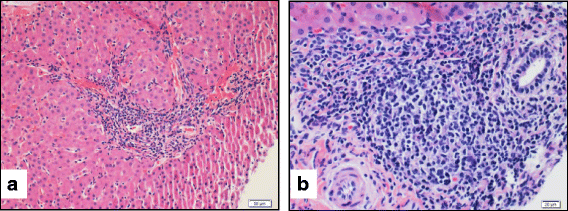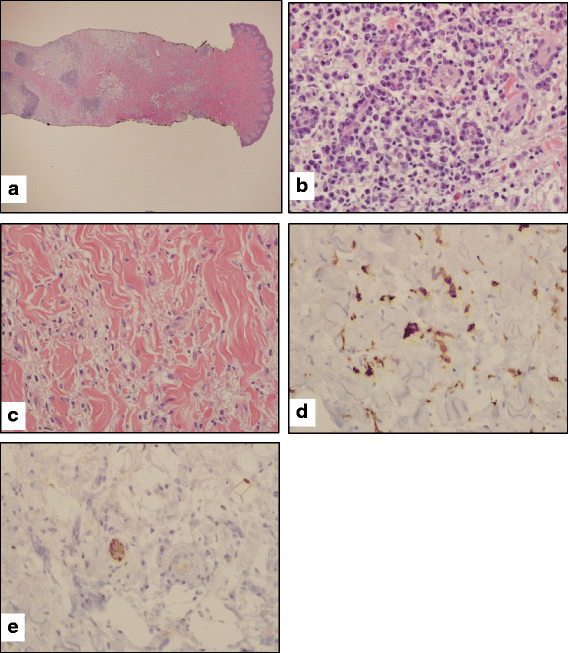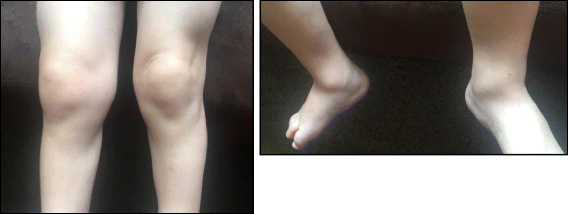H syndrome: 5 new cases from the United States with novel features and responses to therapy
- PMID: 29041934
- PMCID: PMC5645937
- DOI: 10.1186/s12969-017-0204-y
H syndrome: 5 new cases from the United States with novel features and responses to therapy
Abstract
Background: H Syndrome is an autosomal recessive disorder characterized by cutaneous hyperpigmentation, hypertrichosis, and induration with numerous systemic manifestations. The syndrome is caused by mutations in SLC29A3, a gene located on chromosome 10q23, which encodes the human equilibrative transporter 3 (hENT3). Less than 100 patients with H syndrome have been described in the literature, with the majority being of Arab descent, and only a few from North America.
Case presentation: Here we report five pediatric patients from three medical centers in the United States who were identified to have H syndrome by whole exome sequencing. These five patients, all of whom presented to pediatric rheumatologists prior to diagnosis, include two of Northern European descent, bringing the total number of Caucasian patients described to three. The patients share many of the characteristics previously reported with H syndrome, including hyperpigmentation, hypertrichosis, short stature, insulin-dependent diabetes, arthritis and systemic inflammation, as well as some novel features, including selective IgG subclass deficiency and autoimmune hepatitis. They share genetic mutations previously described in patients of the same ethnic background, as well as a novel mutation. In two patients, treatment with prednisone improved inflammation, however both patients flared once prednisone was tapered. In one of these patients, treatment with tocilizumab alone resulted in marked improvement in systemic inflammation and growth. The other had partial response to prednisone, azathioprine, and TNF inhibition; thus, his anti-TNF biologic was recently switched to tocilizumab due to persistent polyarthritis. Another patient improved on Methotrexate, with further improvement after the addition of tocilizumab.
Conclusion: H syndrome is a rare autoinflammatory syndrome with pleiotropic manifestations that affect multiple organ systems and is often mistaken for other conditions. Rheumatologists should be aware of this syndrome and its association with arthritis. It should be considered in patients with short stature and systemic inflammation, particularly with cutaneous findings. Some patients respond to treatment with biologics alone or in combination with other immune suppressants; in particular, treatment of systemic inflammation with IL-6 blockade appears to be promising. Overall, better identification and understanding of the pathophysiology may help devise earlier diagnosis and better treatment strategies.
Keywords: Arthritis; Autoinflammatory; Biologic agents; Genetic disorder; H syndrome; Hyperpigmentation; Pediatric rheumatology; SLC29A3.
Conflict of interest statement
Ethics approval and consent to participate
Not Applicable.
Consent for publication
Written consent obtained.
Competing interests
Dr. Bohnsack has served a site investigator for trials of biologics, including tocilizumab and adalimumab, in Juvenile Idiopathic Arthritis, which were sponsored by the manufacturers. The other authors declare that they have no competing interests.
Publisher’s Note
Springer Nature remains neutral with regard to jurisdictional claims in published maps and institutional affiliations.
Figures




Similar articles
-
Tocilizumab for the Treatment of SLC29A3 Mutation Positive PHID Syndrome.Pediatrics. 2017 Nov;140(5):e20163148. doi: 10.1542/peds.2016-3148. Pediatrics. 2017. PMID: 29079714
-
H syndrome treated with Tocilizumab: two case reports and literature review.Front Immunol. 2023 Aug 11;14:1061182. doi: 10.3389/fimmu.2023.1061182. eCollection 2023. Front Immunol. 2023. PMID: 37638031 Free PMC article. Review.
-
Homozygosity for a novel large deletion in SLC29A3 in a patient with H syndrome.Pediatr Dermatol. 2020 Mar;37(2):333-336. doi: 10.1111/pde.14075. Epub 2019 Dec 22. Pediatr Dermatol. 2020. PMID: 31867772
-
H syndrome: the first 79 patients.J Am Acad Dermatol. 2014 Jan;70(1):80-8. doi: 10.1016/j.jaad.2013.09.019. Epub 2013 Oct 27. J Am Acad Dermatol. 2014. PMID: 24172204
-
Clinical, Histochemical, and Molecular Study of Three Turkish Siblings Diagnosed with H Syndrome, and Literature Review.Horm Res Paediatr. 2019;91(5):346-355. doi: 10.1159/000495190. Epub 2019 Jan 9. Horm Res Paediatr. 2019. PMID: 30625464 Review.
Cited by
-
'H-syndrome': a multisystem genetic disorder with cutaneous clues.BMJ Case Rep. 2021 May 4;14(5):e238973. doi: 10.1136/bcr-2020-238973. BMJ Case Rep. 2021. PMID: 33947670 Free PMC article.
-
H syndrome mimicking Erdheim Chester disease: new entity and therapeutic perspectives.Haematologica. 2023 Aug 1;108(8):2255-2260. doi: 10.3324/haematol.2022.282040. Haematologica. 2023. PMID: 36727401 Free PMC article. No abstract available.
-
Autoimmune hepatitis in genetic syndromes: A literature review.World J Hepatol. 2021 Oct 27;13(10):1328-1340. doi: 10.4254/wjh.v13.i10.1328. World J Hepatol. 2021. PMID: 34786169 Free PMC article. Review.
-
H syndrome with low bone mineral density associated with hypovitaminosis D and low insulin-like growth factor 1.JAAD Case Rep. 2020 Aug 8;6(12):1345-1349. doi: 10.1016/j.jdcr.2020.08.002. eCollection 2020 Dec. JAAD Case Rep. 2020. PMID: 33912641 Free PMC article. No abstract available.
-
Review of the current literature on H syndrome treatment.J Family Med Prim Care. 2022 Mar;11(3):857-860. doi: 10.4103/jfmpc.jfmpc_1435_21. Epub 2022 Mar 10. J Family Med Prim Care. 2022. PMID: 35495792 Free PMC article. Review.
References
-
- Senniappan S, Hughes M, Shah P, Shah V, Kaski JP, Brogan P, et al. Pigmentary hypertrichosis and non-autoimmune insulin-dependent diabetes mellitus (PHID) syndrome is associated with severe chronic inflammation and cardiomyopathy, and represents a new monogenic autoinflammatory syndrome. J Pediatr Endocrinol Metab. 2013;26:877–882. doi: 10.1515/jpem-2013-0062. - DOI - PubMed
Publication types
MeSH terms
Substances
Supplementary concepts
LinkOut - more resources
Full Text Sources
Other Literature Sources

